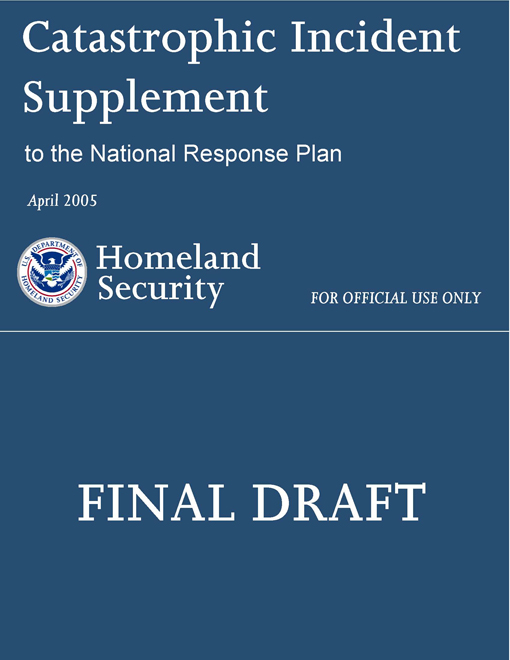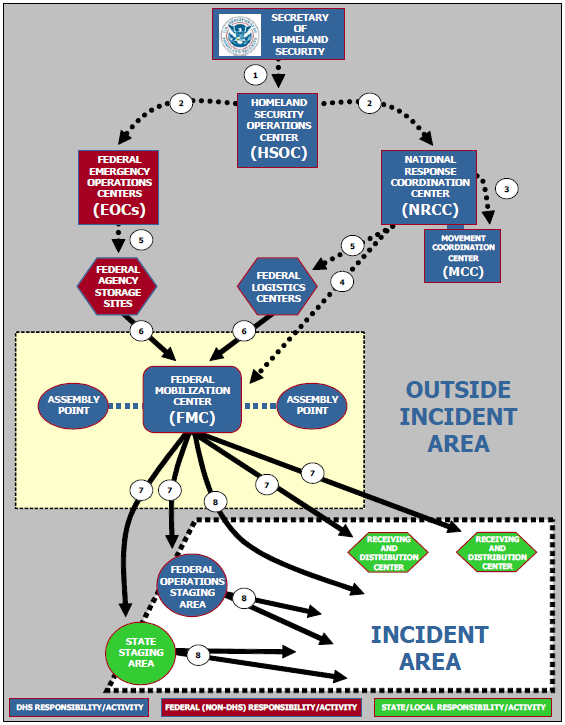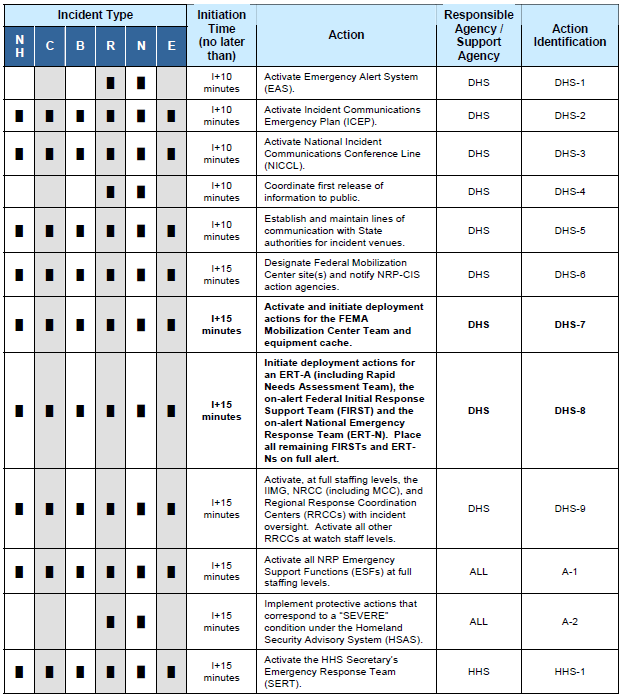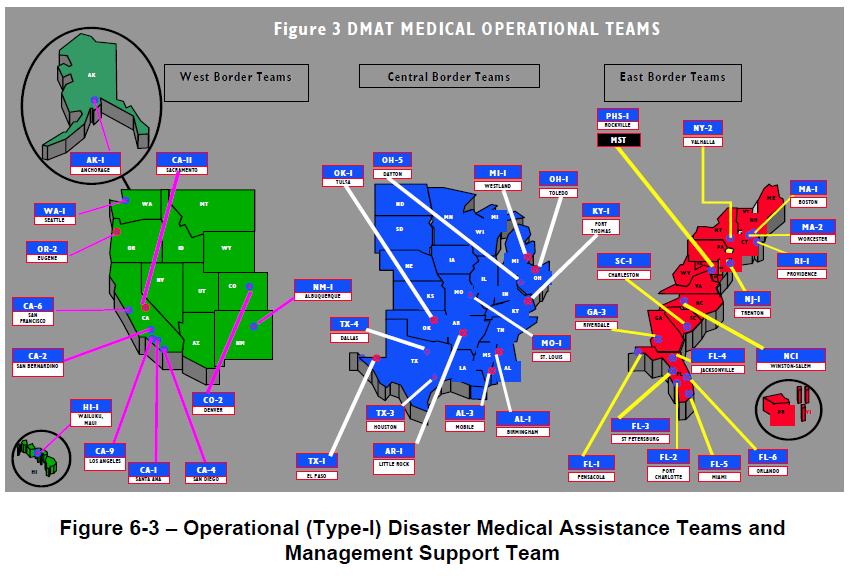Department of Homeland Security
- 170 pages
- Final Draft
- For Official Use Only
- April 2005
This Catastrophic Incident Supplement provides the operational framework for implementing the strategy contained in the National Response Plan Catastrophic Incident Annex, and is effective upon issuance. Departments and Agencies with designated responsibilities under this Catastrophic Incident Supplement (to include those specific response actions listed in the Catastrophic Incident Response Execution Schedule) are authorized 120 days to establish and institutionalize processes and procedures necessary to effectively execute those responsibilities, should the provisions of this Supplement be implemented. Departments and Agencies will notify the Secretary of Homeland Security, in writing, when the necessary processes and procedures are in place.
Should conditions warrant, the Secretary of Homeland Security may implement the provisions contained within the Supplement prior to the expiration of the 120-day process institutionalization period. Within 1 year of its effective date, the Secretary of Homeland Security will conduct an interagency review to assess the effectiveness of the National Response Plan Catastrophic Incident Supplement, identify improvements, and provide modification and reissuance recommendations, as required. The Department of Homeland Security will establish an operational review cycle to ensure regular revalidation of the actions and capabilities listed herein.
…
1. Purpose
The purpose of the Catastrophic Incident Supplement to the National Response Plan (henceforth, NRP-CIS) is to establish a coordinated strategy for accelerating the delivery and application of Federal and Federally accessible resources and capabilities in support of a jurisdictional response to a no-notice or short-notice catastrophic mass victim/mass evacuation incident. Such an incident may result from a technological or natural disaster, or terrorist attack involving chemical, biological, radiological, nuclear,
or high-yield explosive (CBRNE) weapons of mass destruction (WMD). The NRP-CIS provides the operational strategy summarized in the National Response Plan Catastrophic Incident Annex (NRP-CIA).…
3. Overview
A. An urban or metropolitan area, or more expansive geographical area encompassing a large aggregate population, suffers a sudden, catastrophic incident resulting (either immediately or over time) in tens of thousands of casualties (dead, dying, and injured) and producing tens of thousands of evacuees and/or affected-in-place. The response capabilities and resources of the local jurisdiction (to include mutual aid from surrounding jurisdictions and response support from the State) will be profoundly insufficient and quickly, if not immediately, overwhelmed. In addition, characteristics of the precipitating event, such as severe damage to critical and public infrastructure and contamination concerns or other public health implications, will severely aggravate the response strategy and further tax the capabilities and resources available to the venue. Life saving support from outside the area will be required, and time is of the essence. A catastrophic incident is also likely to have long-term impacts within the incident area as well as, to a lesser extent, on the Nation. It is expected that venue capabilities will be exceeded in one
or more of the following areas:(1) Mass Care. The ability of State and local first responders to adequately manage and provide mass care (food and shelter) to a large, displaced, and potentially contaminated evacuee population numbering in the tens of thousands will be quickly exceeded.
(2) Search and Rescue. If the incident involves collapsed structures, organic and mutual aid, search and rescue resources are likely to be extremely limited. If the search and rescue operations are required in areas of contamination, the availability of properly trained and equipped resources will be further reduced.
(3) Decontamination. A WMD incident may involve contamination, and will require State and local first responders and reception center receivers to organize, support, and conduct mass decontamination of casualties (including animals), evacuees, vehicles, and facilities. In addition, it will require the commencement of site characterization as well as monitoring of both air quality and for
contamination among members of the public. Given the potentially immense numbers of casualties, evacuees, vehicles, and facilities resulting from such an incident, decontamination requirements will immediately overwhelm State and local capabilities.(4) Public Health and Medical Support. There will be significant issues relating to environmental health and public health needs, including mental health services and, potentially, isolation and quarantine requirements. Medical support will be required not only at medical facilities, but in large numbers at victim collection and evacuation points, evacuee and refugee points and shelters, and to support field operations and emergency responders. In addition, any contamination dimension will increase the requirement for technical assistance. The situation will quickly tax the organic public health and medical infrastructure.
(5) Medical Equipment and Supplies. Depending on the nature of the incident, organically available supplies of preventive and therapeutic pharmaceuticals and treatments will be insufficient or unavailable to meet the demand, both real and perceived. Additionally, there will be insufficient numbers of qualified medical personnel to administer available treatment to both the affected
and adjacent populations. Timely provision of treatment may be able to forestall additional people becoming ill and reduce the impact of disease among those already exposed.(6) Victim and Fatality Management and Transportation. The number of dead, injured, and exposed may number in the tens of thousands and immediately overwhelm State and local transportation capabilities and infrastructure. In addition, the immense numbers of casualties are likely to overwhelm the bed capacities of State and local medical facilities.
(7) Public Information. A catastrophic mass victim/mass evacuation incident resulting from an act of terrorism may terrify the population, both in the incident area and nationally. If the State and local Government are overwhelmed by the scope and dimensions of the event and unable to provide quick, positive, continuous, consistent, and clear public information and guidance to the affected population, mass confusion and panic may ensue. On a national scale, the Federal Government must be prepared to immediately provide clear and coherent guidance and direction.
…
…
B. Recognizing that Federal and/or Federally accessible resources will be required to support State and local response efforts in some or all of the preceding areas, the Federal Government has preidentified resources (e.g., medical teams, transportable shelters, preventive and therapeutic pharmaceutical caches, Federal medical facilities, cargo and passenger aircraft, etc.) that are expected to be needed/required to support the state and local incident response. Upon NRP-CIS implementation, the Federal Government will act immediately and “push” these predesignated resources to a federal mobilization center or staging area near the incident area, as well as “push” certain actions (e.g., activate or make available Federal facilities, such as hospitals). Upon arrival, these resources will be redeployed to the incident area and integrated into the response operation when requested and approved by – and in collaboration with – appropriate state or local incident command authorities, in accordance with the NRP and NIMS. All “pushed” assets and resources will be 100% federally funded through initial deployment to the Federal mobilization center or staging area. (Note: some Federal departments/agencies may deploy predesignated resources directly to the incident scene under separate statutory incident response authority and direction. In such cases, the department/agency must notify the National Response Coordination Center (NRCC) of the deployment and destination.)
(1) The NRP-CIS recognizes that State and local authorities may or may not ultimately require all of the resources that are initially “pushed” or made available to an incident venue in support of response operations and in anticipation of projected needs. Nevertheless, to assure their timely availability to provide critical and life-saving support, these pre-designated resources will be deployed as rapidly as possible. Additional resources will be deployed (if available) as more precise requirements are subsequently identified through post-incident needs assessments. To ensure that logistical support capabilities are not overwhelmed, Federal resources NOT listed on the Execution Schedule will NOT be deployed without special mission assignment approval.
(2) The development of venue-specific plans that fully integrate and leverage the resources and capabilities of all levels of Government and the private sector into a coordinated incident-specific advance response strategy will further accelerate the delivery and application of support and reduce the ratio of unneeded resources and capabilities within the pre-established Execution Schedule.
…
Appendix 5 – Decontamination Response Overview
1. Mission
In the immediate aftermath of a catastrophic incident involving nuclear, radiological, biological, or chemical contamination, all appropriate Federal departments and agencies will provide technical advice and assistance to State and local governments regarding the decontamination of persons, first responders and medical treatment equipment and facilities, and animals in service. Assistance will include expert personnel and equipment, supplies, and systems to assist in the decontamination of buildings and
equipment (especially those providing essential/critical services), and the environment. During the recovery phase, this assistance may include augmentation/replacement of first responder decontamination resources and capabilities.2. Planning Assumptions
A. Overview. For catastrophic incidents depicted in the planning scenarios related to this plan, decontamination involves several related and sequential activities. Chief among these are (1) immediate (or gross) decontamination of persons exposed to toxic/hazardous substances; (2) continual decontamination of first responders so that they can perform their essential functions; (3) decontamination of animals in service to first responders; (4) continual decontamination of response equipment and vehicles; (5) secondary, or definitive, decontamination of victims at medical treatment facilities to enable medical treatment and protect the facility environment; (6) decontamination of facilities (public infrastructure, business and residential structures); and (7) environmental (outdoor) decontamination supporting recovery and remediation.
B. Decontamination of victims exposed to toxic/hazardous substances is primarily a State and local responsibility, since victim decontamination cannot be delayed pending the arrival of Federal support. However, the Federal Government will provide available decontamination support (coordinated primarily by ESF#8) to State and Local incident management authorities. The primary Federal roles in the immediate aftermath of a catastrophic incident are:
(1) Providing technical advice and assistance for local personnel managing victim decontamination activities.
(2) Obtaining status and assessment information regarding the extent and effectiveness of local decontamination activities in order to analyze their implications for ongoing medical treatment and population protection.
(3) Ensuring that requirements for additional Federal equipment and/or personnel to support local victim decontamination activities are expeditiously obtained and acted upon, to the extent such Federal resources are available.
C. The projected effects of contamination resulting from a catastrophic incident are generally based on an estimated population density of 2,000 people per square mile, but may increase for major urban areas. In addition, large-gathering situations (e.g., National Special Security Events (NSSEs), sporting events, conventions, etc.) create higher localized population densities.
D. Following a nuclear/radiological or chemical incident, and in certain situations for biological agents, decontamination may be required for:
(1) People (victims, including affected responders/workers who are decontaminating buildings and the environment will need their protective equipment decontaminated during response, recovery, and remediation; viable patients with injuries, exposure effects, and potential contamination; victims with no medically significant injuries or requiring only psychological support; and fatalities).
(2) Animals (working rescue and response service animals, companion animals, and livestock).
(3) Equipment (equipment or apparatus required for or of potential use in response, equipment or apparatus required for or of potential use in recovery, and non-critical equipment or apparatus not meeting the first two criteria).
(4) Facilities (facilities and infrastructure required for or of potential use in response, facilities and infrastructure required for or of potential use in recovery, and non-critical facilities and infrastructure not meeting the first two criteria).
(5) Geographic outdoor areas requiring remediation.
…
Appendix 9 – Mass Fatality Response Overview
1. Planning Assumptions
A. A catastrophic incident that produces mass fatalities will place extraordinary demands (including tremendous religious, cultural, and emotional burdens) on local jurisdictions and the families of victims. Accordingly, after a disaster, the timely, safe, and respectful disposition of the deceased is an essential component of an effective response. Accurate, sensitive, and timely public relations are crucial to this effort. A catastrophic incident involving mass fatalities will require Federal assistance to transport, recover, identify, process, and store deceased victims and support final disposition and Personal Effects (PE) processing. The actual work of search and recovery, identifying, and processing the victims can be lengthy and painstaking work, often complicated by the desires of families and the needs of investigative agencies. Most local jurisdictions are not equipped to handle a mass fatality event and will experience profound difficulties managing the disaster.
B. During a mass fatality incident, local jurisdictions will lack sufficient personnel, equipment, and storage capacity to handle significant numbers of deceased victims especially if remains are contaminated. Assistance from Federal, public, and private agencies will be required to assist in the, search and recovery, transportation, tracking, removal, processing, identification, PPE selection, and final disposition of victims and remains. Advanced methods of identification, to include but not limited to DNA typing and information management will be essential to effectively support mass fatality disasters.
C. In the event of a mass casualty event, mutual aid resources and Federal assets will be needed to support local medical examiner/coroner activities, as well as to coordinate public and private assistance to grieving families.
D. The mission of mass fatality management is to:
(1) Recover, transport, appropriately process, and protect all human remains;
(2) Establish victim identities and causes of death; preserve all property found on or adjacent to the bodies; and maintain legal evidence for criminal or civil court action.
(3) Determine identification of the victims, determine the cause of death and release remains promptly to the next of kin if possible.
(4) Prevent further risk to the health of the living for the sake of the dead (this includes staff and those coming to assist).
(5) Provide respect for those who have died and show compassion for their loved ones.
(6) Provide social and psychological assistance for family members and mortuary affairs personnel.
(7) Assist in the pursuit of justice for the perpetrators.




